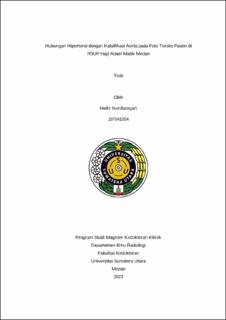Hubungan Hipertensi dengan Kalsifikasi Aorta pada Foto Toraks Pasien di RSUP Haji Adam Malik Medan

Date
2023Author
Nurdiansyah, Hafiz
Advisor(s)
Daulay, Elvita Rahmi
Tarigan, Radar Radius
Metadata
Show full item recordAbstract
Background: Hypertension is an independent risk factor for the development of atherosclerosis and is associated with predisposing factors for aortic calcification. Hypertension can also lead to the acute rupture of plaques by increasing mechanical pressure on already formed plaques. Chest X-ray imaging is commonly used for detecting aortic calcification in routine examinations. Medial arterial calcification appears as tram-track-shaped radiopaque findings, while calcification in the intima is identified as radiopaque spots.
Objective: To determine the frequency distribution of study subjects based on age, gender, degree of hypertension, and degree of aortic calcification and to analyze the relationship between hypertension and aortic calcification in chest X-ray images of patients at RSUP Haji Adam Malik Medan.
Subjects and Methods: A cross-sectional study of 92 samples with hypertension who underwent chest X-ray imaging. Hypertension history was obtained from the patients' medical records. Aortic calcification measurements were performed in the aortic arch by the researcher and a radiology specialist.
Results: The majority of hypertensive patients were above 65 years of age, with 37 samples (40.2%), and the majority were female, with 53 samples (57.6%). The most common degree of hypertension was stage 1 hypertension, with 48 samples (52.2%), and the most common degree of aortic calcification was grade one, with 58 samples (63%). There was a weak, statistically significant positive correlation between hypertension and aortic calcification (p < 0.05; r = 0.196).
Conclusion: There is a weak, statistically significant positive correlation between hypertension and aortic calcification in patients at RSUP Haji Adam Malik Medan.
